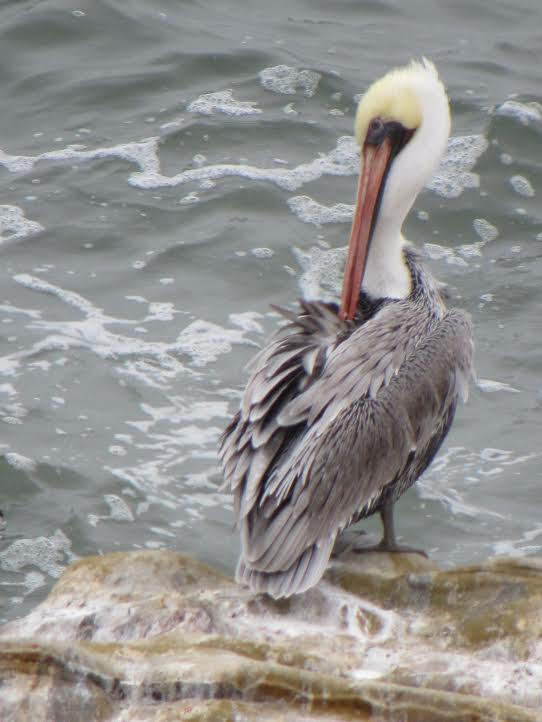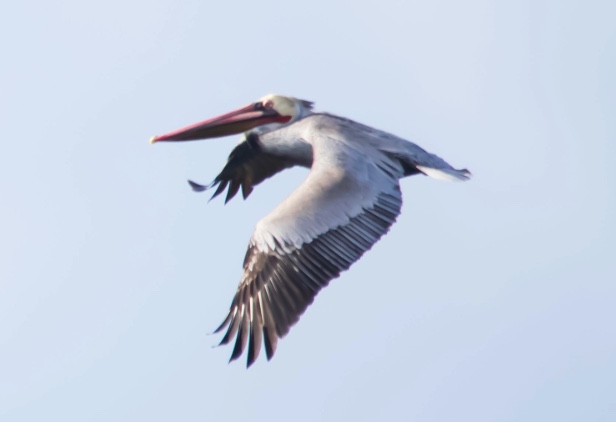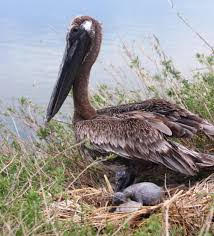"Excuse me, what do you keep in your gular pouch?” Some keep fish. Some blow it up like a balloon. Some use it to look fancy. Some use it to hold food for babies, and others use it for air conditioning! Arguably, the most well-known gular pouch is attached to the Brown Pelican (Pelecanus occidentalis). Cabrillo National Monument is a happy home to a subspecies - the California Brown Pelican (Pelecanus occidentalis californicus) - of these unique birds.

NPS Photo/Violeta Anghel- Brown Pelican Perched on Cabrillo National Monument rock cliff.
The Brown Pelican has a thick layer of skin located on the lower mandible and connected to the throat - this is a gular pouch. The bird uses this flap of skin to scoop fish out of the water, to hold its catch like a dinner plate of regurgitated fish for its chicks, and even to cool itself on a hot day! Many water birds (such as pelicans and cormorants) have this peculiar body part, including tropical water birds like gannets, frigatebirds, and anhingas. The pelican's gular pouch is unique in that it can hold three times more than its stomach. It can hold three gallons and up to 24 pounds in that supple sack of skin! Amazing!
Pelicans have a typical waterfowl diet. The majority of their food is a variety of fish - herring, sheepshead, pigfish, mullet, minnows, smelt, anchovies, and menhaden. They will occasionally eat crustaceans and even lizards as well. Our own coastal Brown Pelican prefers sardines and anchovies. But before they can eat the food, they must capture it! The Brown Pelican is a magnificent diver. They have two adaptations that aid them in fishing - their incredibly sharp eyesight, and a small sharp hook at the end of their bill. They first fly in the air, about 60 feet up. Then when they see a snack, they tuck their wings and dive headfirst into the ocean. If a fish is caught, they tilt their bill down to drain the water from their pouch, then throw back their head and swallow the tasty meal. Sometimes Brown Pelicans act in a tame fashion and approach fishermen for hand-outs!

Photo Courtesy of iNaturalist, User Oleksnatute - A mature Brown Pelican in flight
But the Brown Pelican's gular pouch is not the only interesting thing about it - with a 7-foot wingspan, they're one of the largest birds in California! Although their size is impressive their other features are equally important when identifying this wondrous bird. The Brown Pelican is, you guessed it, pretty much brown. Adult males have a cherry-red gular pouch a chestnut and white neck, and a white head with a yellow crown. The juvenile birds, hatchling to 3 years, and females are more neutral in color. All Brown Pelicans have a blackish-brown belly, tar-black legs and four webbed toes. Their beaks have a sharp hook at the end to aid in catching slippery fish. They weigh approximately 3,740 grams (8.2 pounds) and are about 51 inches tall when fully grown. What an amazing creature!
Brown Pelicans live across the United States and in Southern Ontario, Canada. They live both on the Atlantic and the Pacific coasts. Although pelicans are mostly seen on the shores of North America, they are commonly seen at the Salton Sea and sometimes even in freshwater in British Columbia and Nova Scotia. They grace the coast of Cabrillo National Monument year-round.

Photo Courtesy of Louisiana Department of Wildlife and Fisheries - Female pelican on nest with two chicks.
Brown Pelicans nest in colonies. They perch on the ground, the side of cliffs, and on low trees. The nest is made by the female with the materials gathered by the male. Depending on the terrain on which the nest is built, it may consist of different components. For example, a ground or cliff nest might be scraped into the soil or a heap of debris with a depression in the center. Whereas a tree nest will be made of sticks. Pelicans three to five years of age begin laying eggs. They lay their eggs in the spring. There is one brood a year, which will commonly have two to four chalky white eggs, but typically has three. These eggs are incubated by both the female and the male, taking turns. In 28 to 36 days, the eggs will hatch. The hatchlings emerge hungry and are fed by both of the parents. When about 5 weeks have passed, the baby birds that have hatched on the ground start to explore. They move around in huddles with their fellow hatchlings. However, it takes a little while longer for the chicks in tree nests to start climbing branches, about nine weeks. The first flight takes place in 9-12 weeks.
Cabrillo National Monument has been a safe habitat for the Brown Pelican since it opened in 1913. Come visit them and see what they might have hidden in their gular pouch!
References:
Diet, Food, Young, Nest
audubon.org/field-guide/bird/brown-pelican
Size, Location:
DUNN, JON L. AND ALDERFER, JONATHAN
October 20, 2009
National Geographic Illustrated Birds of North America Folio Edition
United States
National Geographic Society
|
January 23, 2020
|
Last updated: January 23, 2020
